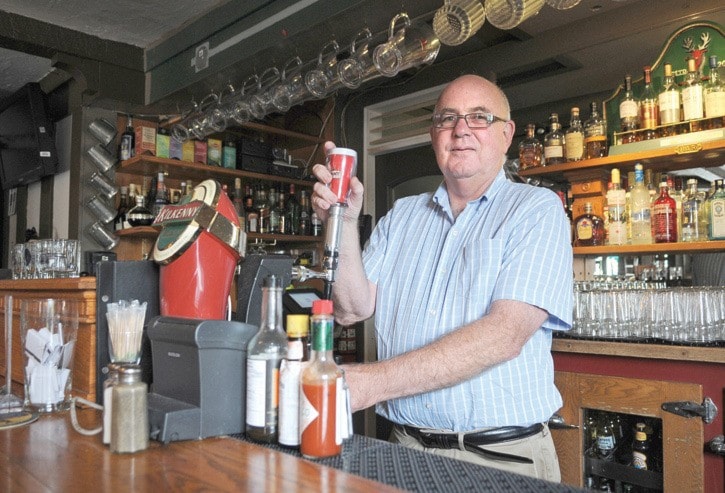It’s been a full year since tougher impaired driving penalties were brought in, accompanied by stories from pubs across the province that the new rules were a blow to business. The laws came on the heels of the new harmonized sales tax, which had already hurt sales.
“We’ve experienced changes in people’s patterns of how much they’ll come in and how much they’ll spend when they come in,” said Brian Dunn, owner of Smugglers’ Cove Pub in Cadboro Bay. “It’s shifted more toward food.”
September means good things for the pub, located a short walk from the University of Victoria. Back to school means more business, but the seasonal boost isn’t enough to sustain the pub throughout the year. Dunn has ramped up the focus on food, including bringing back a Sunday brunch. He admits he has thought of becoming a pub-style restaurant, but giving up his pub licence is not an option he’d like to explore. Neither is implementing a shuttle service – one option to which several businesses are turning.
Last year, at this time the News checked in with Diego Trozzo, owner of the Bird of Paradise, who had just started shuttling customers to and from the pub after a 26-per-cent loss in sales he attributed to the impaired driving changes. This year, Trozzo says even with the shuttle, his business is down somewhere near 35 per cent and he’s uncertain how long he can take those losses.
“(Pub owners) have been hanging in there, doing whatever they can to subsidize the losses, accessing personal equity and then there gets to the point where you just can’t do it anymore,” he added. “People don’t have pockets that deep to survive when business is that bad for that long.”
At the Saanich Roadhouse Bar and Grill, co-owner Fran Jinnouchi decided to open her second business during the period of decline for neighbourhood pubs.
The difference in her business model? The Roadhouse is a pub-style restaurant.
The Roadhouse has only been open since Aug. 9 and already Jinnouchi, who also owns Evedar’s Bistro in Langford, is considering a shuttle service for patrons who decide to drink.
Jinnouchi, like other owners, sees the tougher business climate as reason to offer something more to customers – be it live local music or transportation.
Garth Whyte, president and CEO of the Canadian Restaurant and Foodservices Association, says the trend toward foodservice over liquor sales is national – and one that’s forcing pubs to compete more than ever in an effort to keep their traditional clientele.
“Pubs have been very responsive to their customers and they are diversifying,” Whyte said, noting that pubs are trying to accommodate the shift and some are now even open for breakfast.
In Canada, in the last decade, the number of drinking establishments has shrunk from 9,000 to 6,000, due in part to establishments changing their licensing to restaurant status.
In B.C. the numbers have dropped 17.5 per cent, from 880 to 726 over the same period.
This comes after liquor sales were already on the decline nationally between 2003 and 2008. In 2003, food sales in pubs accounted for 14 per cent of sales at pubs in Canada. By 2008, two years before the HST and liquor penalties changed, that number grew to 18 per cent.
“There will always be a need for a neighbourhood pub and pubs are changing, not just in Canada, but around the world,” Whyte said.
nnorth@saanichnews.com
Did you know?
• Licensed restaurants may serve any kind of liquor, so long as a full range of appetizers and main courses are available and being served, whenever liquor is available.
• Pubs as well as any business in the hospitality, entertainment or beverage industry – including bars, lounges, nightclubs, stadiums, theatres, recreation and convention centres – may apply for a liquor-primary licence and are not required to sell food.
WHAT HAPPENED?
On Sept. 20, 2010, the province introduced the toughest impaired driving penalties in Canada.
• Drivers who blow above 0.08 on a breathalyzer or refuse to provide a breath sample face an immediate, 90-day driving ban; a $500 fine; vehicle impoundment for 30 days; the possibility of criminal charges.
• Drivers who blow between 0.05 and 0.08, in “the warn range,” face a three-day driving ban and a $200 fine if caught once, a seven-day ban and a $300 fine if caught twice, and a 30-day ban with $400 fine, if caught a third time.
• According to the Canadian Restaurant and Foodservice Association, liquor sales at restaurants fell by 21 per cent in the four months following the introduction of new impaired driving penalties.
• A survey conducted by the association in the spring showed that 88 per cent of licensed restaurant and bar operators said the new .05 penalties resulted in a drop in liquor sales.
•Nine out of 10 restaurateurs have reported a drop in sales since the HST took effect on July 1, 2010.
